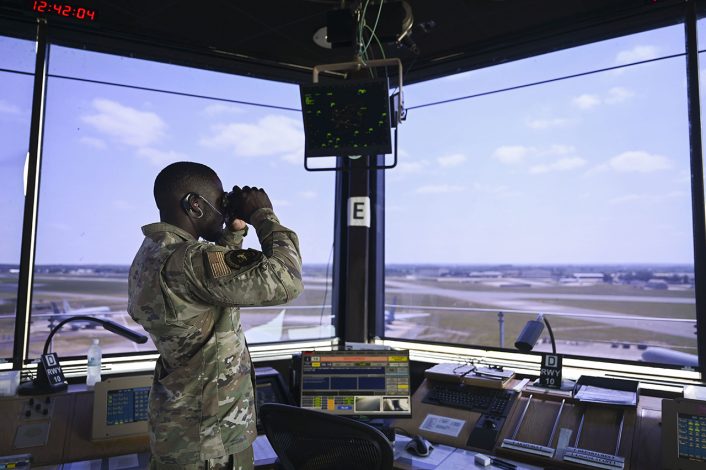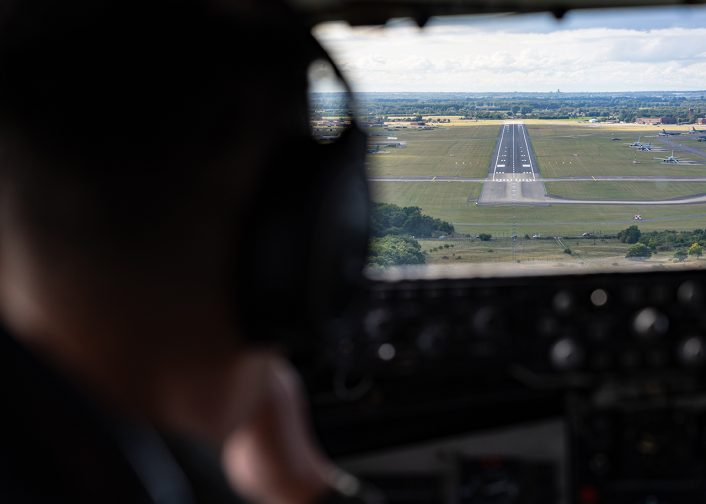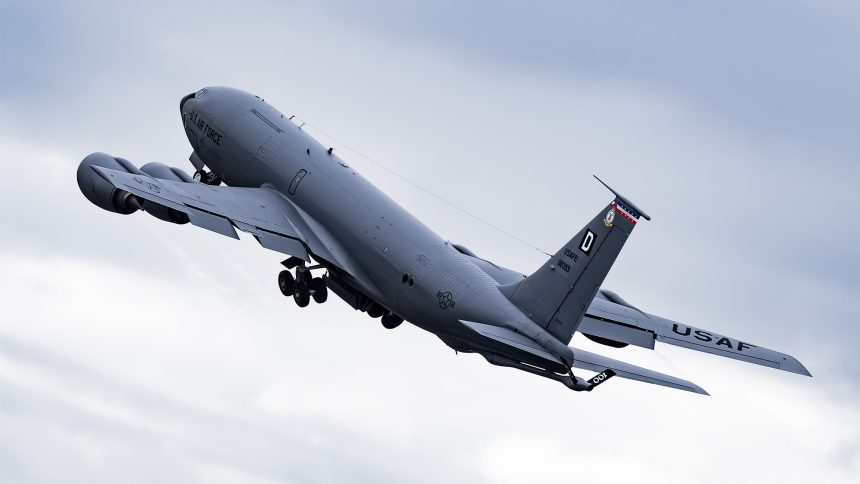Calls for a specific squawk code to be designated for gliders have emerged after a USAF KC-135 Stratotanker came within 15 metres of colliding with a glider over Eastern England.
On Apr. 8, 2025, a KC-135R Stratotanker from the 100th Air Refueling Wing was conducting circuit training at its home base, RAF Mildenhall, when the pilot in command identified a Jonker JS-1 glider ahead of the aircraft on a converging path at a similar altitude. The pilot commanded a roll to the right, with approximately 30 degrees of bank, to avoid a collision.
Speaking to the investigation board called to report on the incident, the pilot stated that the two aircraft came within 100 feet, or 30 metres, of each other horizontally. Other data obtained by the board, known as an Airprox (Aircraft Proximity) Board, suggested the aircraft actually came within 50 feet, or 15 metres, of colliding. Crew members on board the KC-135 report that had they not completed the evasive maneuver there was a ‘good chance’ the two aircraft could have collided.

The Airprox Board categorized the incident at the highest level – Category A – meaning there was a serious risk of collision.
The glider pilot, who assessed the risk of collision as “low”, was flying outside of Mildenhall’s air traffic zone, and as such was not required to be in contact with air traffic control despite the generally busy airspace. Additionally, to conserve battery power, the transponder aboard the glider was not enabled. This practice is permissible for aircraft with a reduced power availability, like gliders, and is often standard practice unless airspace rules mandate its use. The pilot reported that he kept the transponder disabled to avoid inadvertently confusing air traffic control with the selected squawk code – 7000 – being used to designate an aircraft not in receipt of an air traffic control service.
Our Radar Analysis Cell works alongside the UK Airprox Board, UK Border Force, Air Accident Investigation Branch, and other agencies, providing critical radar data to support incident investigations and continuously enhance UK air safety. pic.twitter.com/VeDCkVA71f
— 78 Squadron (Swanwick) (@78SqnSwanwick) August 7, 2025
As stated in the report: “A secondary consideration is the fact that their departure and destination point was located in Class D airspace and if they used the conspicuity code 7000 and forgot to switch it off when returning to [their destination] it could have caused huge problems [with the pertinent ATC unit] who have to assume an intruder. [They then stated that] because they are human and therefore capable of forgetting things, again, they leave their transponder off.”
Although squawk codes exist for use by aircraft engaged in parachute drops, target towing, powerline inspection, search and rescue, medical services, and more, to point out flights with specific or potentially unusual operating characteristics, there is no designated squawk code in the UK for use by gliders. The assignment of such a squawk was suggested by the glider pilot, and this was taken on as a recommendation by the Airprox Board to the UK Civil Aviation Authority. With a more clear method of identifying themselves, it would be hoped that more glider pilots would be encouraged to fly with their Mode S transponders enabled, hence making them more visible to air traffic controllers.

While air traffic control can use primary radar to detect non-transponding aircraft, gliders present a relatively small radar cross-section and additionally, due to their often fairly low operating altitude, can be misinterpreted among ground clutter caused by the land, buildings, antennas, wind turbines, and the like.
The Airprox Board agreed that the avoidance of a collision in this case came down largely to providence – that is, essentially, luck. Aviation investigations usually make use of a blameless culture – the goal of an investigation is to analyse what went wrong, and how to avoid it in the future, rather than attempting to assign blame upon any party. This is to encourage pilots to speak freely and openly about incidents they have been involved in. You can read the full Airprox report here.
Previous Incidents
The busy skies over the UK, particularly over the Eastern regions where there is a particular focal point of military bases and training areas, lend themselves to complex airspace and a number of aircraft proximity incidents. The U.S. Air Force is no stranger to these, including in incidents involving other foreign military aircraft. One such incident in 2024 saw a KC-135 come within 600 feet of an Airbus C-295 off the East coast of Scotland. Then, again, the year prior another KC-135 was involved in an Airprox incident with a Grob G115.
It should be noted, though, that these incidents are far from a U.S. Air Force specific issue, and instead are common across aviation. In 2024, the Airprox Board oversaw a total of 298 incidents. 27 of these were deemed Category A, 93 as Category B, 122 as Category C, 13 as Category D, and 43 as Category E. 48% of incidents over the prior 10 years involved general aviation aircraft in conflict with other general aviation aircraft. 15% involved general aviation aircraft in conflict with military aircraft, while 7% involved military aircraft conflicting with other military aircraft.
🔊 Our latest Safety Files podcast highlights the potential risks when flying near or above active gliding sites.
✅We also talk to the UK Airprox Board about a recent incident at a gliding site.
Listen here 👉 https://t.co/XJEjpjDZhQ pic.twitter.com/pnKa0ugf98
— UK Civil Aviation Authority (@UK_CAA) September 11, 2023
One factor apparent in many Airprox Reports is the ever more complicated nature of airspace in the UK vs the amount of operational airfields and airstrips across the country. Flight paths for instrument landing systems (ILS) at major airfields often end up incidentally conflicting with small airstrips or airfields. These ILS zones are not necessarily restricted airspace in any way – air traffic controllers and pilots simply must maintain extra vigilance, especially in areas where light aircraft are known to transit.

Directly underneath the approach for Runway 10 at Mildenhall, for example, are Sutton Meadows and Chatteris airfields, both regularly used by light civilian traffic. It is additionally mentioned in the report that the “controller was aware of the prevalence of non-transponding glider traffic that transits the area.”
Modern transponders, which include ADS-B out functionality – transmitting the aircraft’s GPS location at all times – are immensely helpful for both air traffic control and for pilots in avoiding close calls. Even transponders in legacy modes, simply Mode A/C, or Mode 3, transmitting a squawk code and altitude readout in response to a secondary surveillance radar interrogation, heavily reduce the risk of collision. As electrically powered aircraft become more common, the industry will need to find a way to make sure these systems can be supported adequately and reliably throughout an aircraft’s entire flight, and reduce the need for power-conscious pilots to disable features that could save theirs, and others’, lives.









